Raising Water Consciousness through
World’s Biggest Photo Exhibition and
Largest collection of Photo Stories on Water
Photo Stories | Water and EnvironmentA story based on the theme of World Water Day 2017
Wastewater Reuse: Some Reflections
Nandita Singh and Om Prakash Singh
30 April, 2017
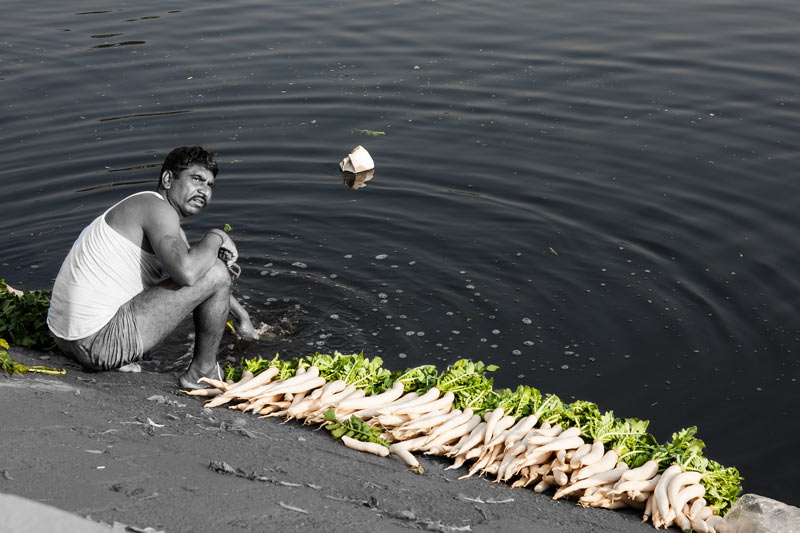
Wastewater reuse, which implies using wastewater or reclaimed water from one application for another application, offers multiple benefits for different water use sectors. This, in turn, has led to its promotion in recent times as the sustainable way forward for mitigating the increasing stress on water resources in terms of quality as well as quantity. In India, wastewater reuse, with or without recycle, has been in practice in different forms and for different purposes. This spans across agricultural, urban, industrial, recreational and environmental uses. Agricultural reuse of wastewater is most common with untreated or partially treated municipal and, in some cases, also industrial wastewater diverted for irrigation. Wastewater irrigation helps raise foodcrops as well as fodder, fruits and vegetables. Large-scale washing of vegetables for the market may also be carried out using wastewater. In some urban areas, wastewater is reused for landscape irrigation such as in parks, school yards, highway medians, golf courses, and private residential lawns. Common industrial reuse comprises its utilization in processing, cooling and in boilers. Recreational use primarily comprises maintenance of water volume in lakes and pools where boating and other recreational activities are organized. Environmental reuse primarily involves restoring and maintaining surface water bodies such as lakes and streams, as well as recharging underground aquifers. In its reuse, wastewater is undoubtedly a valuable resource that not only consists primarily of water which can be put to the similar uses as freshwater, but also contains nutrients for crops such as phosphorous and nitrogen, which otherwise need to be applied externally through fertilizers. However, while best benefits are achieved when adequately recycled wastewater is reused, in India the trend is to reuse wastewater that is either raw or only partially treated. This raises serious concerns regarding human as well as environmental health. This current trend of reuse can thus thwart the enjoyment of human rights by women, men and children, particularly to water, health, culture and development and also pose challenges to sustainable development through multiple pathways. This photo story aims to present some reflections over the practice of wastewater reuse in India. The title photo depicts radish being cleaned for the market using wastewater from Agra Canal in South-East district, National Capital Territory of Delhi.
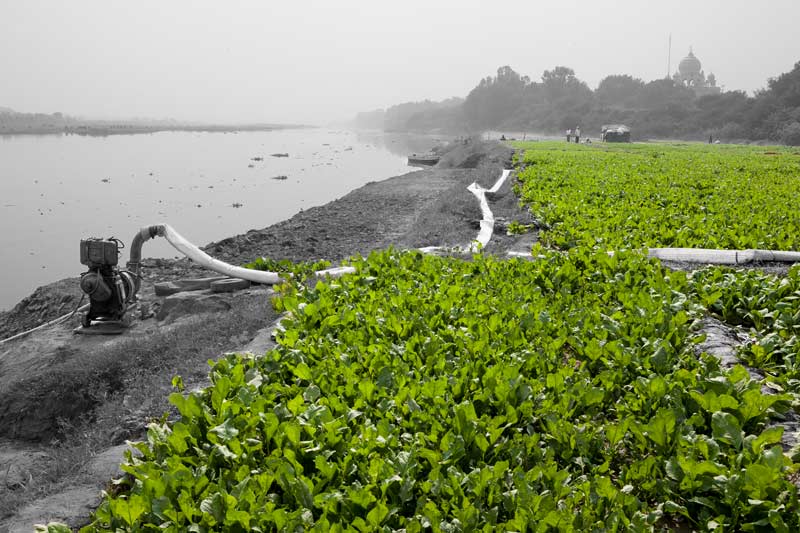
Irrigating spinach fields with wastewater drawn from river Yamuna in Central district, National Capital Territory of Delhi
Yamuna river in Delhi has come to be declared as an open drain that receives large amounts of raw sewage as well as untreated industrial effluents from different parts of the city, besides some treated wastewater from the city's sewage treatment plants (STPs) and common effluent treatment plants (CETPs). However, the wastewater in the river contains nutrients (nitrogen, phosphorus and potassium), which aid in rich crop growth, besides reducing the need for synthetic fertilizers. Various vegetables like cucurbits, eggplant, okra, and coriander in the summers; and spinach, mustard, radish, cauliflower, and cabbage in the winters are cultivated along the banks of the river at many places, irrigated with the wastewater drawn directly from the river. Though economically gainful, helping the farmers earn up to four times more compared to freshwater irrigation, the impact of the practice on environment and public health is large. Land and water resources in the area are known to turn saline and get contaminated with chemicals and heavy metals contained in the wastewater. These are also known to enter the foodchain and end up adversely affecting the health of those women, men and children who consume these vegetables.
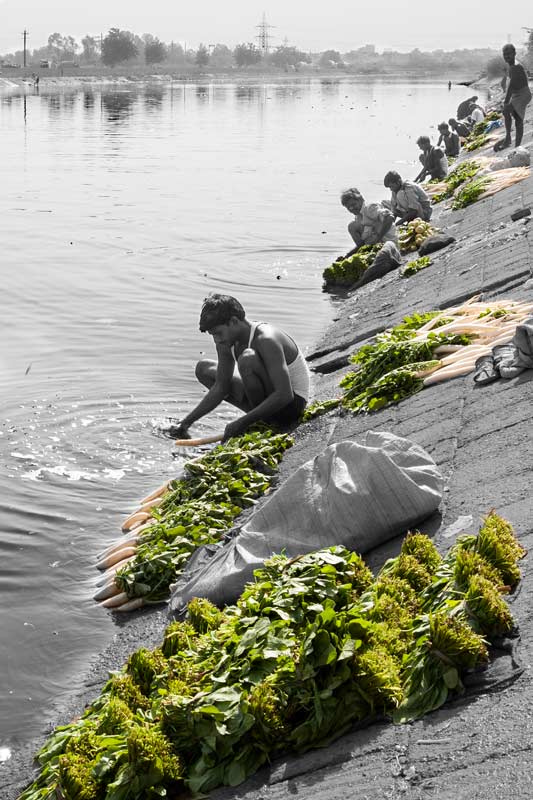
Washing spinach and radish for the market with predominantly untreated wastewater on the banks of Agra Canal in South-East district, National Capital Territory of Delhi
The Agra Canal is an important irrigation work that originates from river Yamuna in the south of Delhi and extends upto Agra. It irrigates about 150,000 hectares in Agra, and Mathura in Uttar Pradesh, Faridabad in Haryana, Bharatpur in Rajasthan and also some parts of Delhi. Since river Yamuna in Delhi is heavily polluted with untreated and partially treated sewage and industrial wastewater, the water in Agra Canal proves to be an excellent cleaning liquid, with of course serious health implications for the consumers. Therefore consumers be warned that clean and fresh looking vegetables may be deceptive. These may actually be carrying many pathogens and dangerous chemicals and hence unhygienic to consume since these are washed with polluted water.
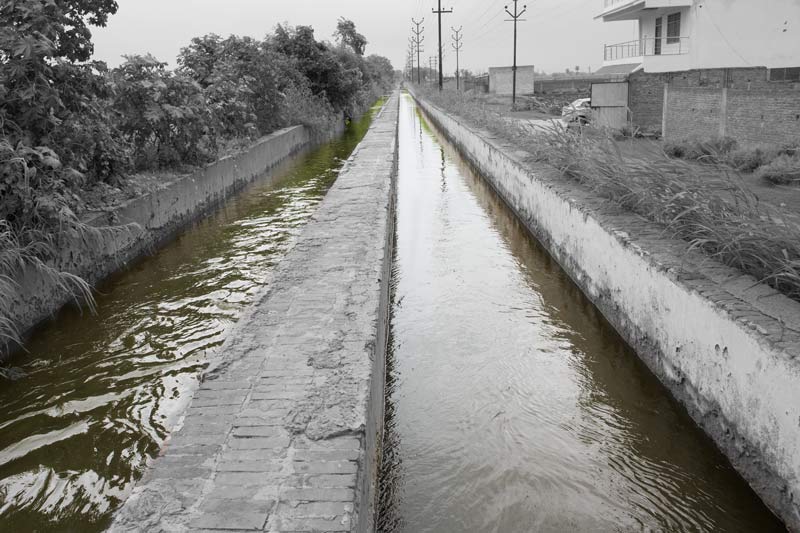
Shekhpur Canal carrying recycled wastewater for irrigation to villages near Jajmau industrial area, Kanpur, Uttar Pradesh
In Jajmau industrial area, treated wastewater containing sewage and tannery effluents mixed in the ratio 3:1 has been supplied to farmers for more than two decades for irrigating crops through the Shekhpur Canal. It is estimated that irrigation with sewage or sewage mixed with industrial effluents can result in saving of 25-50 % of nitrogen and phosphorous fertilizer and lead to 15-27 % higher crop productivity. However, according to farmers in these villages, crop productivity has sharply declined after introduction of recycled wastewater irrigation. Intensive land application has led to accumulation of salts in the soil, odor problems, and salt and color leaching affecting groundwater and downstream water quality. The drinking water sources in the villages are contaminated and breeding of mosquitoes and other insects is common due to open sewage drains. Common diseases in the area such as dermatitis, eczema, ulcers, cancer, malaria, dengue, and stone in kidney and gall bladder, are particularly prevalent in the villages where 'recycled' wastewater is supplied. Further, heavy metals in tannery effluents, notably chromium, risk entering the food chain affecting larger populations. This raises serious doubt over the quality of the so-called 'recycled' wastewater in use.
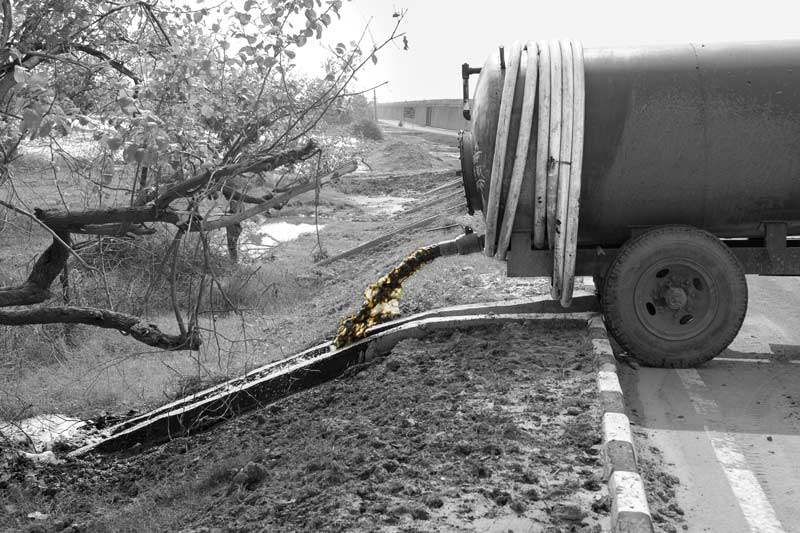
Raw sewage from septic tank applied to a orchard of ber (Ziziphus mauritiana) trees in Hissar district, Haryana
Irrigation of fruit orchards with sewage water is emerging as a common practice in a number of places. In the area depicted in the photo, raw sewage collected from private septic tanks located in Hansi town is purchased by farmers to raise fruit orchards. This practice is beneficial for them since application of sewage increases the productivity several times, while reducing costs for pumping out scarce groundwater in this semi-arid area.
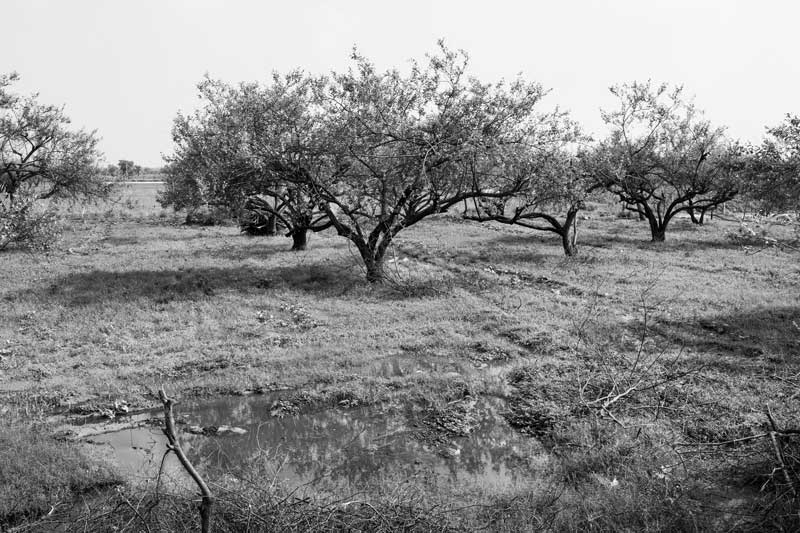
An orchard of ber (Ziziphus mauritiana) trees irrigated and nurtured by raw sewage from septic tanks in Hissar district, Haryana
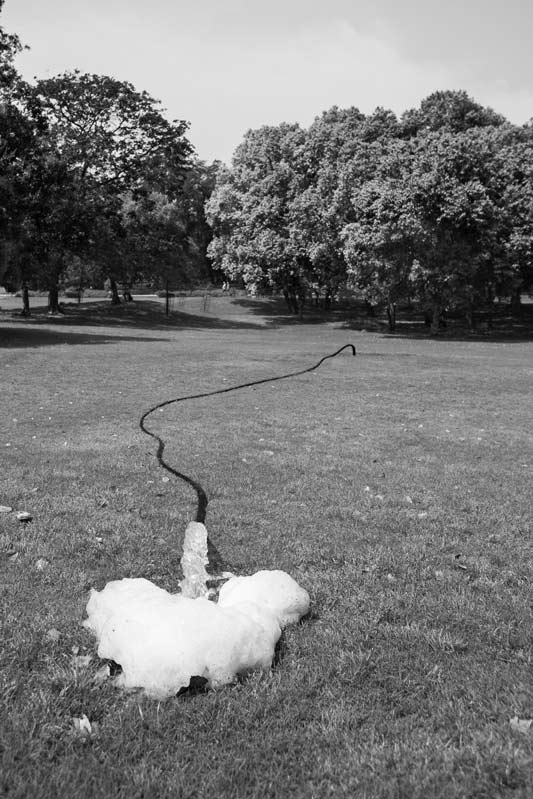
Irrigating Lodi Garden lawns with recycled wastewater in South-East district, National Capital Territory of Delhi
Lodi Garden is a large city park situated in New Delhi spread over 90 acres of land. Watering such large recreational spaces with recycled wastewater is a welcome practice since it helps cut down the huge demand on fresh water resources in a city like Delhi where groundwater as well as surface water resources are already scarce. Besides, irrigation with recycled wastewater also provides nutrients to the plants and grass, thereby further reducing investments in landscape maintenance. Irrigation of public parks, highway medians, and even private residential lawns with treated wastewater is found in many other parts of Delhi as well as other urban centres in the country.
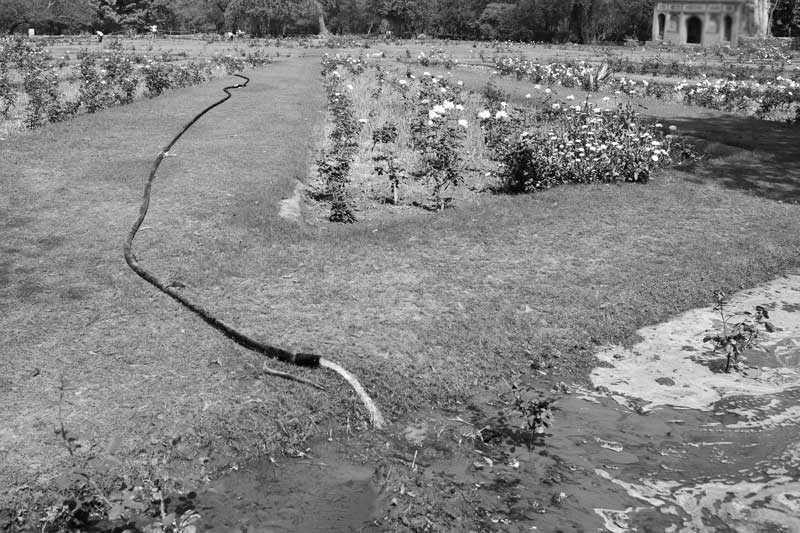
Irrigating rose plants in Lodi Garden with recycled wastewater in South-East district, National Capital Territory of Delhi
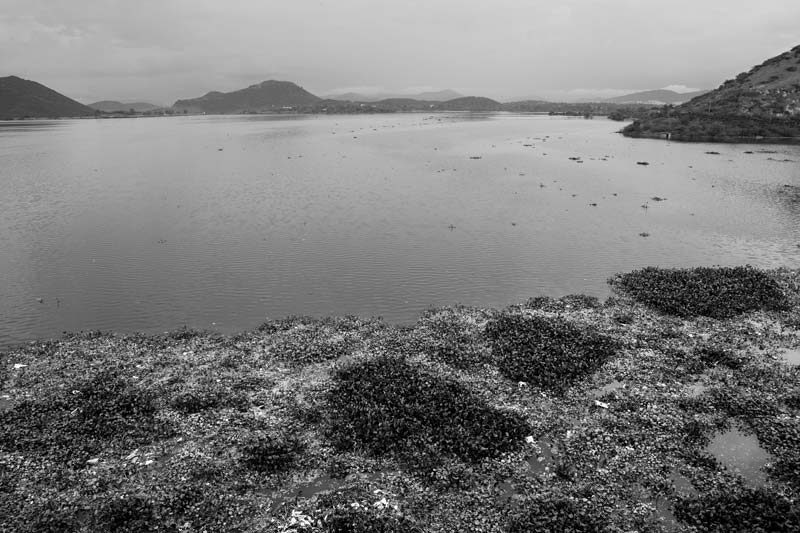
Udai Sagar Lake - the sewage reservoir of Udaipur city, Rajasthan - an important source of irrigation water in the area
Udai Sagar was a lake created in history to serve as a water source for the city of Udaipur. However, in present times, it has become the recipient of the city's untreated sewage conveyed to it through the Ahar river. A part of the lake's wastewater is reused for irrigation by distribution through canals in about 10 big villages in Udaipur, Chittorgarh and Bhilwara districts which enables agriculture even in the rain deficient seasons and years.
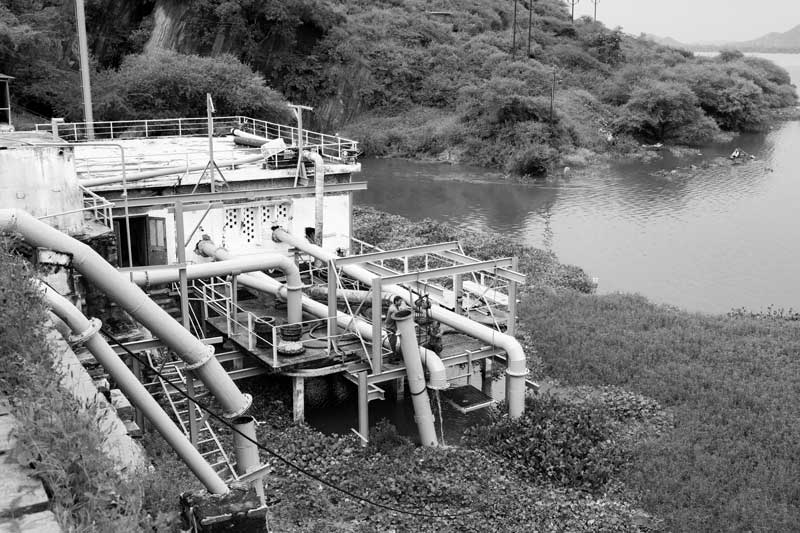
Wastewater from Udai Sagar Lake taken for industrial use by Hindustan Zinc Limited near Udaipur city, Rajasthan
The wastewater contained in Udai Sagar is also reused by Hindustan Zinc Limited – the second largest zinc producer in the world - for its industrial activities in the zinc smelter close by in Debari.
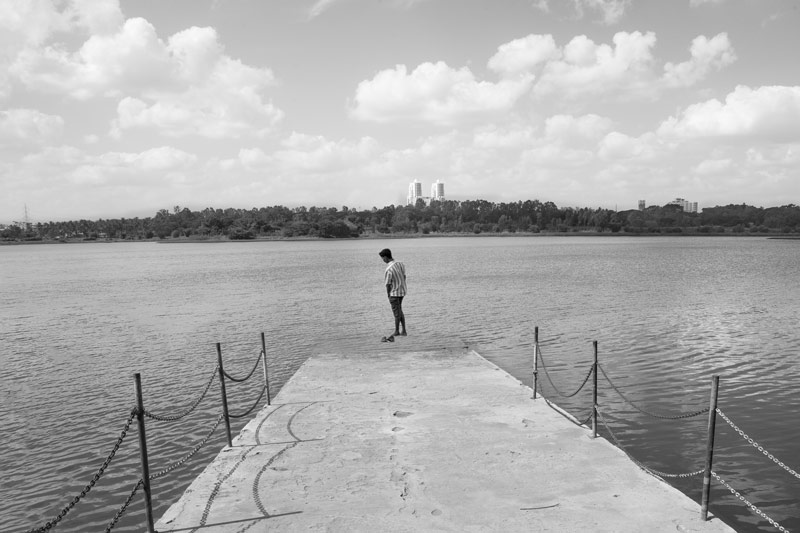
Hebbal Lake maintained largely through reuse of treated and untreated sewage in Bengaluru, Karnataka
Hebbal Lake is a privatized lake developed, rejuvenated and maintained by the Oberoi Group, which has signed a 15-years contract with the government for its development for recreation and tourism purposes, besides recharging ground water and help maintaining eco-balance. The developments include building a boating jetty, a handicraft and curio gift centre and an island restaurant. It is believed that that this would increase the recreation options for the people and also support bio-diversity. In order to maintain the lake as a point of tourist attraction, it is important to maintain adequate water level in the lake. At present, the lake gets its water from 3 sources – treated and untreated sewage and rainwater. Except in the rainy season, the water level is maintained through treated and untreated sewage. The untreated sewage enters through a number of stormwater drains. Treated sewage comes largely from two sources – the private STP operated by the Oberoi Group, and the 60 MLD STP run by the Bangalore Water Supply and Sewerage Board (BWSSB). According to a recent project undertaken by the BWSSB, about 30% of the treated sewage from its STP is to be led into the lake for dilution with rain water with the purpose of revival of the depleted groundwater level in the area.
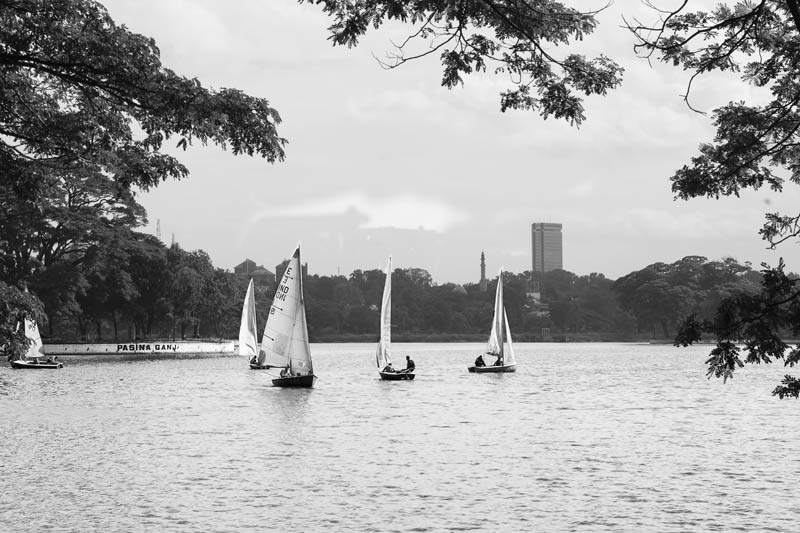
Wastewater reuse helping promote tourism and recreational activities in Ulsoor Lake in Bengaluru, Karnataka
Ulsoor is one of the biggest lakes in the heart of Bengaluru city, spread over 50 hectares. Originally fed by rainwater from a catchment spanning 1.5 sq. km., it was built by the family of Kempegowda II in 17th and 18th centuries, for drinking and irrigation purposes. However, in present times during the rainy season, rainwater mixed with untreated sewage flows into the lake through stormwater drains, while in the dry season untreated sewage becomes the primary inflow. Considering the expanse and volume of water in Ulsoor Lake, notwithstanding its quality, Karnataka State Tourism Development Corporation operates boating service for tourists. Thus, Ulsoor stands as a good example of tourism and recreational activities being promoted mainly through wastewater reuse, although untreated. However, considering the health and environment of the lake, in March 2017 the Karnataka government has decided to build a STP with a capacity of 100,000 litres within a period of 6 months. Once functional, sewage water will be treated in the plant before being let into the lake. This will enable continuation of tourism and recreation at the lake through reuse of recycled wastewater.
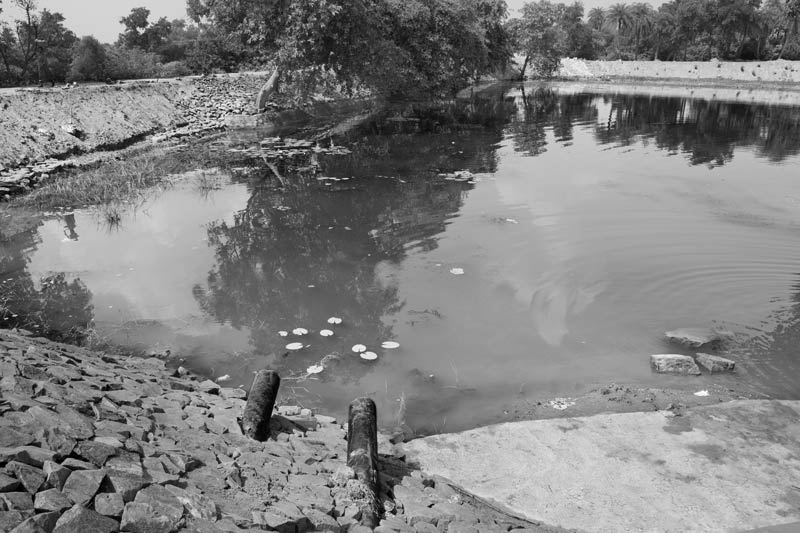
A village pond recharged through recycled wastewater from surface coalmine in Dhanbad district, Jharkhand
The mining industry generally has an impact on groundwater resources due to the need for continuous dewatering. This often leads to water stress in mining communities especially in the dry season. In the coal mining area in Dhanbad district, continuous dewatering activities have led to lowering of the water table in the city as well as neighboring villages. The mining wastewater so generated can be treated and reused for recharging depleted aquifers as well as rejuvenation of dried up surface water bodies. In Baghmara block of Dhanbad district, the Bharat Coking Coal Limited (BCCL) has implemented a multipurpose project where the mining wastewater is first treated and then supplied to villages in the area with the aim of removing water scarcity problem especially in the dry season, recharge groundwater and in general improve ecosystem services, and promote socio-economic upliftment of local communities. This pond in Behrakudar village receives treated mining wastewater from the coalmine area as aresult of which water level is upheld throughout the year as well as the drinking water sources based on groundwater in the vicinity remain recharged.
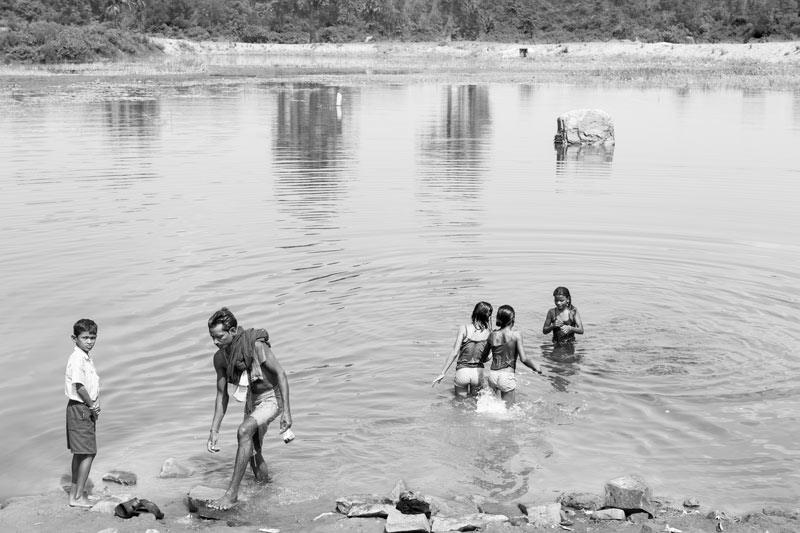
A village pond recharged with recycled mine wastewater in use by villagers for daily chores in Dhanbad district, Jharkhand
Recharging of village ponds with recycled wastewater from coalmines is a useful approach. It greatly facilitates women, men and children in the villages especially during the dry summer months with recharged water sources nearby for drinking as well as other non-potable uses. However, care needs to be taken by the authorities that the recycling of mine wastewater should meet the optimum level so that the standards set for water quality for different human and environmental uses are reached. It is important for the colliery authorities to note that the recycled mine wastewater can also have another important use. It can be reused for spraying to settle the dust in the open cast coal mines, for which gallons of groundwater are otherwise freshly withdrawn on a daily basis, thereby unnecessarily adding to the pressure on the already depleting groundwater resources.
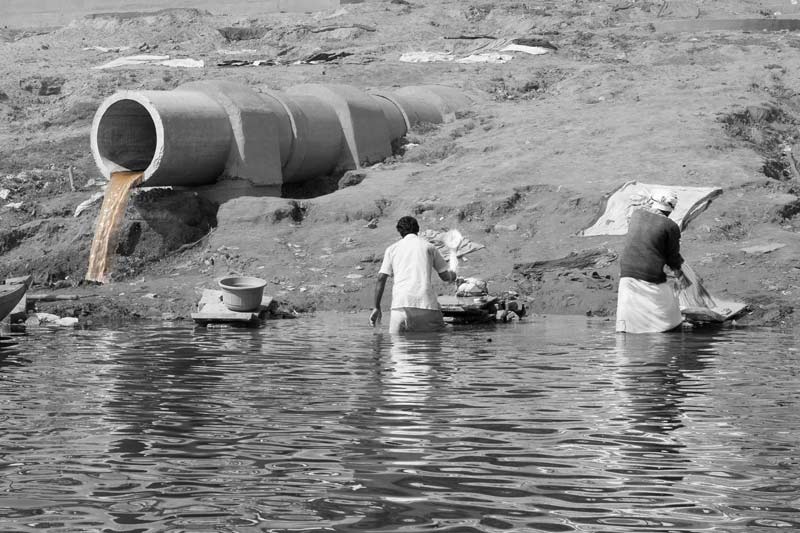
Washermen doing laundry at the confluence of raw sewage and river water on the banks of river Ganga in Varanasi, Uttar Pradesh
On the banks of river Ganga in Varanasi, untreated sewage is often diverted into the river from the municipal sewerage system due to nonfunctioning of STPs on ground of power cuts or technical problems. Sewage often contains high concentrations of chemicals from soaps, detergents and other cleaning agents which facilitate easy cleaning of clothes which is also more efficient and cost-effective. Consequently some washermen prefer to clean clothes at points where raw sewage is discharged into the river. However, untreated sewage also contains fecal coliform count (FCC) as high as 80,000/100ml while safe limit for bathing is less than 500/100ml, according to standards set by the Central Pollution Control Board (CPCB). Wearing of clothes washed with such microbially polluted water thus pose high risk of infection to the users. Reuse of sewage-containing water for laundry is a practice quite common in many cities and towns in the country.
This photo story has presented glimpses of varied types of wastewater reuse found in India. From these presentations it emerges that wastewater reuse in the country is based on recycled as well as raw wastewater, and hence is like a double-edged sword. Use of recycled wastewater is definitely a viable solution for meeting many of the multidimensional challenges facing the country's water resources, especially in a climate change regime that enhances the pressures. Among the major benefits are: availability of additional, reliable and cost-effective source of water for non-potable uses in industrial and urban settings; an additional source to meet ever-increasing agricultural water demand that also enables reduction in fertilizer use, increase in overall farm incomes, reduction in ground water pumping, reduction in energy requirements due to reduced water pumping; and consequently greenhouse gas mitigation. However, intensive reuse of untreated wastewater especially for irrigation and for urban landscaping, recreational and environmental purposes can have substantial negative impacts on land, water and environment in general. Additionally, there is also the question of optimum recycling of the wastewater so that it can reach the required quality standards for the given reuse. If precautions on the quality front are not taken, people's access to safe water, good health, livelihood, etc. may be thwarted. Given the multiple benefits, there is definitely a need to promote wastewater reuse in the country through adoption of an integrated approach. Towards this end, governments at all levels must engage in long-term strategic planning and reforms to promote reuse of treated wastewater, and also ensure that wastewater treatment is appropriately and adequately carried out before reuse is made. Simultaneously there is also need to adopt awareness campaigns to sensitize different stakeholders like farmers, businesses, industries and consumers about relevant wastewater issues, impacts and their roles in the process. Such an approach can help promote safe reuse of wastewater so that the best of both worlds can be drawn, thereby promoting enjoyment of human rights by women, men and children, and protectíng environmental health and sustainability in a climate change regime.